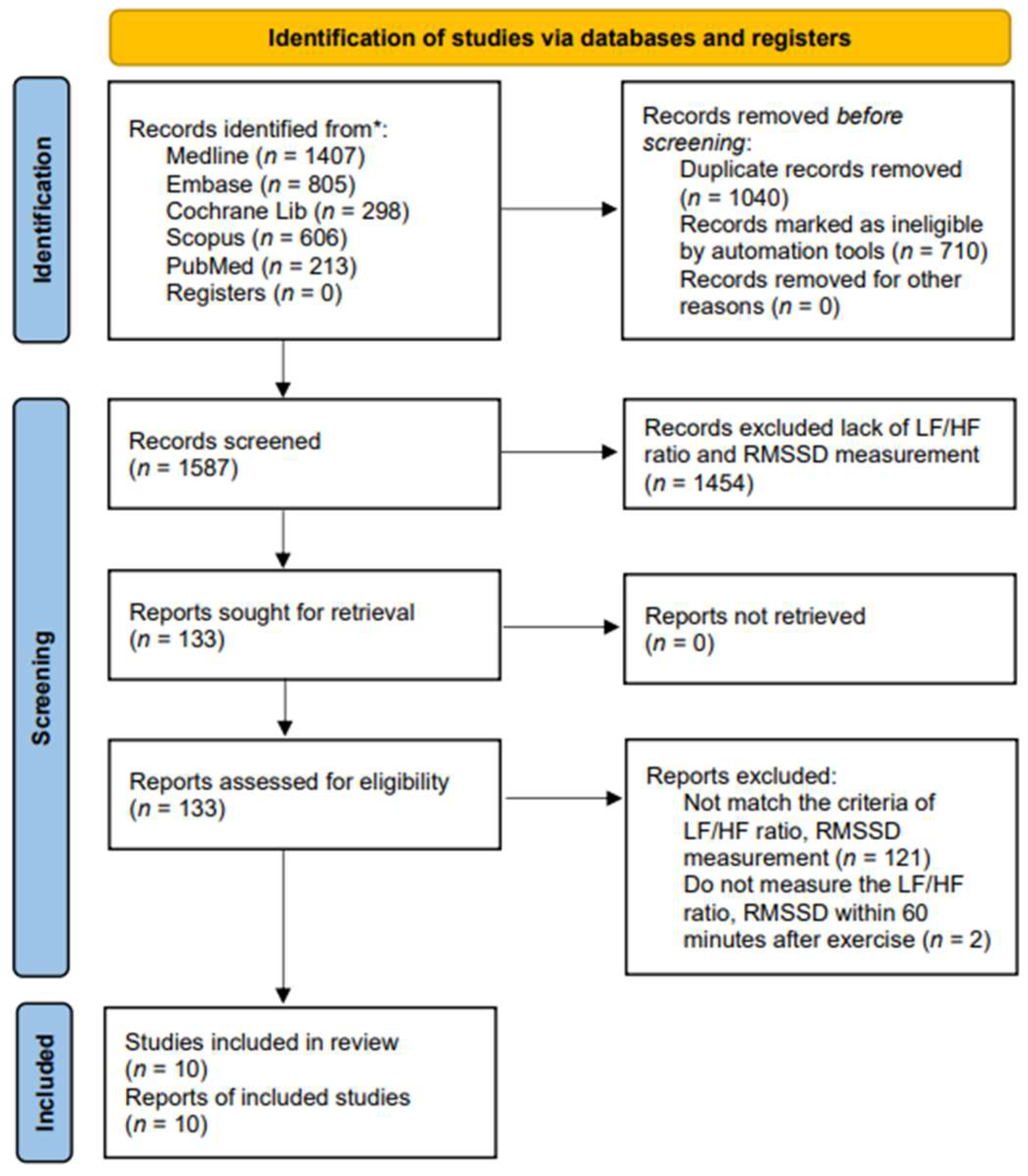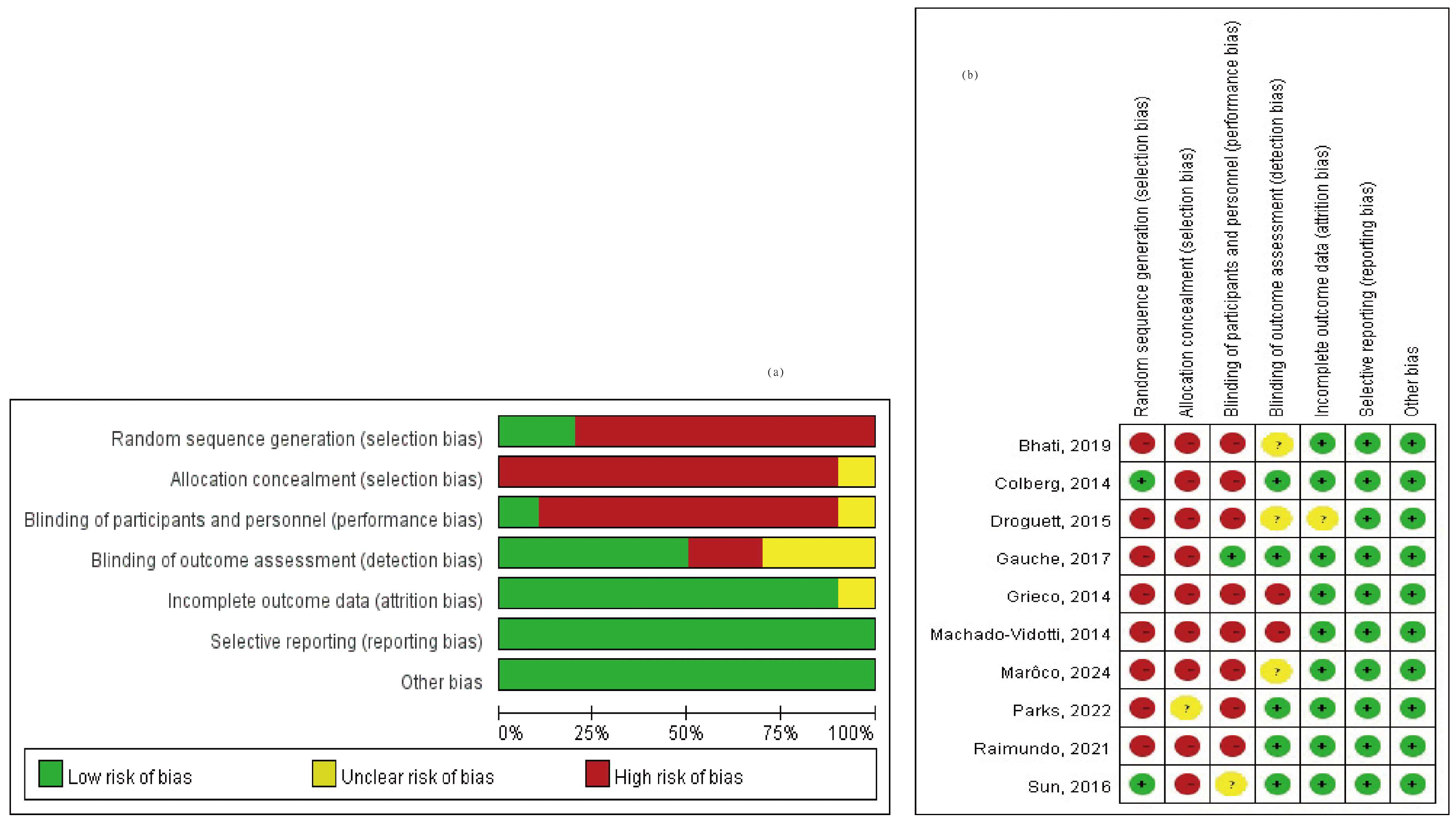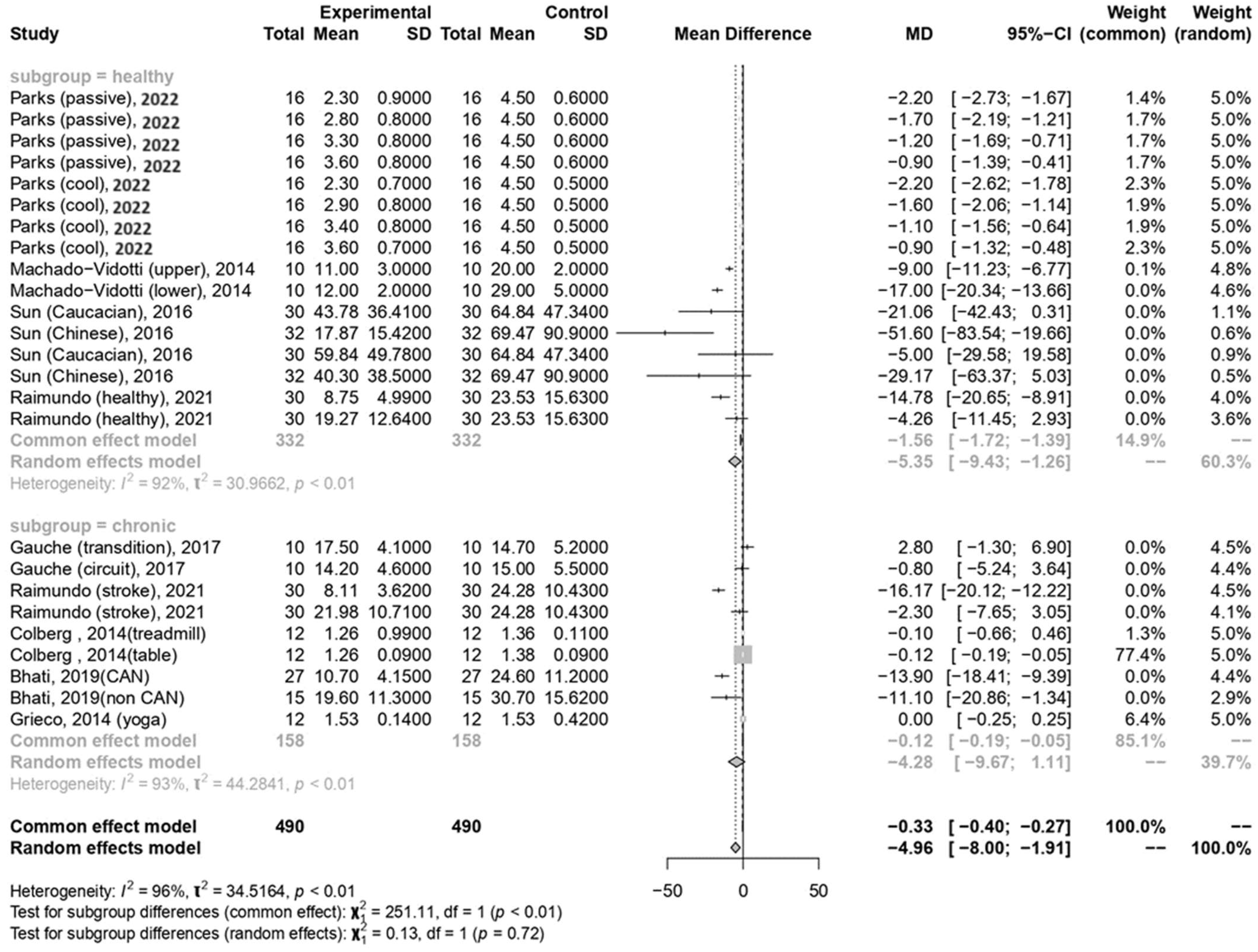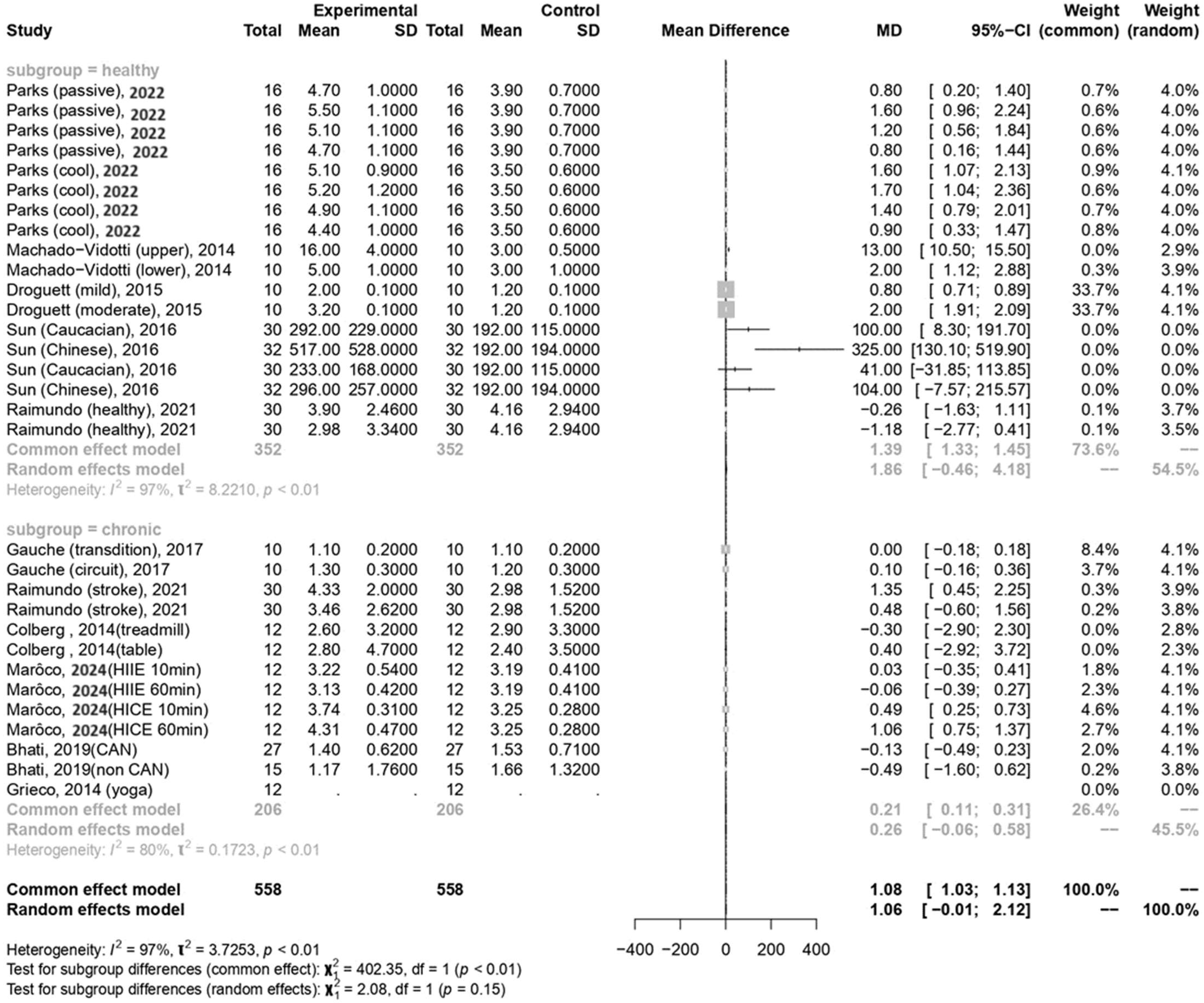The Impact on Autonomic Nervous System Activity during and Following Exercise in Adults: A Meta-Regression Study and Trial Sequential Analysis
Abstract
:1. Introduction
2. Materials and Methods
2.1. Study Design
2.2. Search Strategy
2.3. Study Selection
2.4. Data Extraction
2.5. Methodological Quality of Included Studies
2.6. Risk of Bias of Included Studies
2.7. Statistical Analysis
3. Results
4. Discussion
5. Conclusions
Supplementary Materials
Author Contributions
Funding
Institutional Review Board Statement
Informed Consent Statement
Data Availability Statement
Conflicts of Interest
References
- Lear, S.A.; Hu, W.; Rangarajan, S.; Gasevic, D.; Leong, D.; Iqbal, R.; Casanova, A.; Swaminathan, S.; Anjana, R.M.; Kumar, R.; et al. The effect of physical activity on mortality and cardiovascular disease in 130 000 people from 17 high-income, middle-income, and low-income countries: The PURE study. Lancet 2017, 390, 2643–2654. [Google Scholar] [CrossRef] [PubMed]
- Pedersen, B.K.; Saltin, B. Exercise as medicine–evidence for prescribing exercise as therapy in 26 different chronic diseases. Scand. J. Med. Sci. Sports 2015, 25 (Suppl. S3), 1–72. [Google Scholar] [CrossRef]
- Kodama, S.; Saito, K.; Tanaka, S.; Maki, M.; Yachi, Y.; Asumi, M.; Sugawara, A.; Totsuka, K.; Shimano, H.; Ohashi, Y.; et al. Cardiorespiratory fitness as a quantitative predictor of all-cause mortality and cardiovascular events in healthy men and women: A meta-analysis. JAMA 2009, 301, 2024–2035. [Google Scholar] [CrossRef] [PubMed]
- Dishman, R.K.; Nakamura, Y.; Garcia, M.E.; Thompson, R.W.; Dunn, A.L.; Blair, S.N. Heart rate variability, trait anxiety, and perceived stress among physically fit men and women. Int. J. Psychophysiol. 2000, 37, 121–133. [Google Scholar] [CrossRef] [PubMed]
- Furlan, R.; Piazza, S.; Dell’Orto, S.; Gentile, E.; Cerutti, S.; Pagani, M.; Malliani, A. Early and late effects of exercise and athletic training on neural mechanisms controlling heart rate. Cardiovasc. Res. 1993, 27, 482–488. [Google Scholar] [CrossRef]
- Vega, R.B.; Konhilas, J.P.; Kelly, D.P.; Leinwand, L.A. Molecular Mechanisms Underlying Cardiac Adaptation to Exercise. Cell Metab. 2017, 25, 1012–1026. [Google Scholar] [CrossRef] [PubMed]
- Lean, M.E.; Leslie, W.S.; Barnes, A.C.; Brosnahan, N.; Thom, G.; McCombie, L.; Peters, C.; Zhyzhneuskaya, S.; Al-Mrabeh, A.; Hollingsworth, K.G.; et al. Primary care-led weight management for remission of type 2 diabetes (DiRECT): An open-label, cluster-randomised trial. Lancet 2018, 391, 541–551. [Google Scholar] [CrossRef] [PubMed]
- Hambrecht, R.; Wolf, A.; Gielen, S.; Linke, A.; Hofer, J.; Erbs, S.; Schoene, N.; Schuler, G. Effect of exercise on coronary endothelial function in patients with coronary artery disease. N. Engl. J. Med. 2000, 342, 454–460. [Google Scholar] [CrossRef]
- Anderson, L.; Thompson, D.R.; Oldridge, N.; Zwisler, A.D.; Rees, K.; Martin, N.; Taylor, R.S. Exercise-based cardiac rehabilitation for coronary heart disease. Cochrane Database Syst. Rev. 2016, 2016, CD001800. [Google Scholar] [CrossRef]
- Taylor, R.S.; Sagar, V.A.; Davies, E.J.; Briscoe, S.; Coats, A.J.; Dalal, H.; Lough, F.; Rees, K.; Singh, S.J.; Mordi, I.R. Exercise-based rehabilitation for heart failure. Cochrane Database Syst. Rev. 2014, 2014, CD003331. [Google Scholar] [CrossRef]
- Zhang, Y.; Cao, H.; Jiang, P.; Tang, H. Cardiac rehabilitation in acute myocardial infarction patients after percutaneous coronary intervention: A community-based study. Medicine 2018, 97, e9785. [Google Scholar] [CrossRef] [PubMed]
- Flynn, K.E.; Pina, I.L.; Whellan, D.J.; Lin, L.; Blumenthal, J.A.; Ellis, S.J.; Fine, L.J.; Howlett, J.G.; Keteyian, S.J.; Kitzman, D.W.; et al. Effects of exercise training on health status in patients with chronic heart failure: HF-ACTION randomized controlled trial. JAMA 2009, 301, 1451–1459. [Google Scholar] [CrossRef] [PubMed]
- Meyer, K.; Schwaibold, M.; Westbrook, S.; Beneke, R.; Hajric, R.; Gornandt, L.; Lehmann, M.; Roskamm, H. Effects of short-term exercise training and activity restriction on functional capacity in patients with severe chronic congestive heart failure. Am. J. Cardiol. 1996, 78, 1017–1022. [Google Scholar] [CrossRef] [PubMed]
- Experience from controlled trials of physical training in chronic heart failure. Protocol and patient factors in effectiveness in the improvement in exercise tolerance. Eur. Heart J. 1998, 19, 466–475. [CrossRef] [PubMed]
- Riehle, C.; Wende, A.R.; Zhu, Y.; Oliveira, K.J.; Pereira, R.O.; Jaishy, B.P.; Bevins, J.; Valdez, S.; Noh, J.; Kim, B.J.; et al. Insulin receptor substrates are essential for the bioenergetic and hypertrophic response of the heart to exercise training. Mol. Cell. Biol. 2014, 34, 3450–3460. [Google Scholar] [CrossRef]
- Vettor, R.; Valerio, A.; Ragni, M.; Trevellin, E.; Granzotto, M.; Olivieri, M.; Tedesco, L.; Ruocco, C.; Fossati, A.; Fabris, R.; et al. Exercise training boosts eNOS-dependent mitochondrial biogenesis in mouse heart: Role in adaptation of glucose metabolism. Am. J. Physiol. Endocrinol. Metab. 2014, 306, E519–E528. [Google Scholar] [CrossRef] [PubMed]
- Tao, L.; Bei, Y.; Lin, S.; Zhang, H.; Zhou, Y.; Jiang, J.; Chen, P.; Shen, S.; Xiao, J.; Li, X. Exercise Training Protects Against Acute Myocardial Infarction via Improving Myocardial Energy Metabolism and Mitochondrial Biogenesis. Cell. Physiol. Biochem. 2015, 37, 162–175. [Google Scholar] [CrossRef] [PubMed]
- Ashor, A.W.; Lara, J.; Siervo, M.; Celis-Morales, C.; Oggioni, C.; Jakovljevic, D.G.; Mathers, J.C. Exercise modalities and endothelial function: A systematic review and dose-response meta-analysis of randomized controlled trials. Sports Med. 2015, 45, 279–296. [Google Scholar] [CrossRef] [PubMed]
- Tsoupras, A.; Lordan, R.; Zabetakis, I. Inflammation, not Cholesterol, Is a Cause of Chronic Disease. Nutrients 2018, 10, 604. [Google Scholar] [CrossRef]
- Kasapis, C.; Thompson, P.D. The effects of physical activity on serum C-reactive protein and inflammatory markers: A systematic review. J. Am. Coll. Cardiol. 2005, 45, 1563–1569. [Google Scholar] [CrossRef]
- Beavers, K.M.; Brinkley, T.E.; Nicklas, B.J. Effect of exercise training on chronic inflammation. Clin. Chim. Acta 2010, 411, 785–793. [Google Scholar] [CrossRef] [PubMed]
- Antunes-Correa, L.M.; Kanamura, B.Y.; Melo, R.C.; Nobre, T.S.; Ueno, L.M.; Franco, F.G.; Roveda, F.; Braga, A.M.; Rondon, M.U.; Brum, P.C.; et al. Exercise training improves neurovascular control and functional capacity in heart failure patients regardless of age. Eur. J. Prev. Cardiol. 2012, 19, 822–829. [Google Scholar] [CrossRef] [PubMed]
- Malfatto, G.; Facchini, M.; Sala, L.; Branzi, G.; Bragato, R.; Leonetti, G. Effects of cardiac rehabilitation and beta-blocker therapy on heart rate variability after first acute myocardial infarction. Am. J. Cardiol. 1998, 81, 834–840. [Google Scholar] [CrossRef] [PubMed]
- Roveda, F.; Middlekauff, H.R.; Rondon, M.U.; Reis, S.F.; Souza, M.; Nastari, L.; Barretto, A.C.; Krieger, E.M.; Negrao, C.E. The effects of exercise training on sympathetic neural activation in advanced heart failure: A randomized controlled trial. J. Am. Coll. Cardiol. 2003, 42, 854–860. [Google Scholar] [CrossRef] [PubMed]
- Straznicky, N.E.; Lambert, E.A.; Nestel, P.J.; McGrane, M.T.; Dawood, T.; Schlaich, M.P.; Masuo, K.; Eikelis, N.; de Courten, B.; Mariani, J.A.; et al. Sympathetic neural adaptation to hypocaloric diet with or without exercise training in obese metabolic syndrome subjects. Diabetes 2010, 59, 71–79. [Google Scholar] [CrossRef] [PubMed]
- Tonacio, A.C.; Trombetta, I.C.; Rondon, M.U.; Batalha, L.T.; Kuniyoshi, F.H.; Laterza, M.C.; Suzuki, P.H.; Gowdak, M.M.; Barretto, A.C.; Halpern, A.; et al. Effects of diet and exercise training on neurovascular control during mental stress in obese women. Braz. J. Med. Biol. Res. 2006, 39, 53–62. [Google Scholar] [CrossRef] [PubMed]
- Laterza, M.C.; de Matos, L.D.; Trombetta, I.C.; Braga, A.M.; Roveda, F.; Alves, M.J.; Krieger, E.M.; Negrao, C.E.; Rondon, M.U. Exercise training restores baroreflex sensitivity in never-treated hypertensive patients. Hypertension 2007, 49, 1298–1306. [Google Scholar] [CrossRef] [PubMed]
- Ehlers, T.S.; Sverrisdottir, Y.; Bangsbo, J.; Gunnarsson, T.P. High-Intensity Interval Training Decreases Muscle Sympathetic Nerve Activity in Men With Essential Hypertension and in Normotensive Controls. Front. Neurosci. 2020, 14, 841. [Google Scholar] [CrossRef] [PubMed]
- Marcal, I.R.; Abreu, R.M.; Cornelis, N.; Leicht, A.S.; Forjaz, C.L.M.; Cucato, G.; Brenner, I.; Novakovic, M.; Ritti-Dias, R.; Ciolac, E.G.; et al. Effects of exercise training on heart rate variability in individuals with lower extremity arterial disease and claudication: A systematic review. J. Vasc. Nurs. 2023, 41, 226–234. [Google Scholar] [CrossRef]
- Raimundo, R.D.; Zangirolami-Raimundo, J.; Leone, C.; de Carvalho, T.D.; da Silva, T.D.; Bezerra, I.M.P.; de Almeida, A.D., Jr.; Valenti, V.E.; de Abreu, L.C. The Use of Cardiac Autonomic Responses to Aerobic Exercise in Elderly Stroke Patients: Functional Rehabilitation as a Public Health Policy. Int. J. Environ. Res. Public Health 2021, 18, 11460. [Google Scholar] [CrossRef] [PubMed]
- McCraty, R.; Shaffer, F. Heart Rate Variability: New Perspectives on Physiological Mechanisms, Assessment of Self-regulatory Capacity, and Health risk. Glob. Adv. Health Med. 2015, 4, 46–61. [Google Scholar] [CrossRef] [PubMed]
- Shaffer, F.; Ginsberg, J.P. An Overview of Heart Rate Variability Metrics and Norms. Front. Public Health 2017, 5, 258. [Google Scholar] [CrossRef]
- Li, K.; Rudiger, H.; Ziemssen, T. Spectral Analysis of Heart Rate Variability: Time Window Matters. Front. Neurol. 2019, 10, 545. [Google Scholar] [CrossRef] [PubMed]
- Tracy, L.M.; Ioannou, L.; Baker, K.S.; Gibson, S.J.; Georgiou-Karistianis, N.; Giummarra, M.J. Meta-analytic evidence for decreased heart rate variability in chronic pain implicating parasympathetic nervous system dysregulation. Pain 2016, 157, 7–29. [Google Scholar] [CrossRef] [PubMed]
- Billman, G.E. The LF/HF ratio does not accurately measure cardiac sympatho-vagal balance. Front. Physiol. 2013, 4, 26. [Google Scholar] [CrossRef]
- Zeid, S.; Buch, G.; Velmeden, D.; Sohne, J.; Schulz, A.; Schuch, A.; Trobs, S.O.; Heidorn, M.W.; Muller, F.; Strauch, K.; et al. Heart rate variability: Reference values and role for clinical profile and mortality in individuals with heart failure. Clin. Res. Cardiol. 2023; online ahead of print. [Google Scholar] [CrossRef]
- AlQatari, A.A.; Alturki, J.A.; Abdulali, K.A.; Alhumud, D.A.; Alibrahim, M.A.; Alarab, Y.A.; Salem, A.M.; Yar, T.; Alqurashi, Y.D.; Alsunni, A.A.; et al. Changes in Heart Rate Variability and Baroreflex Sensitivity During Daytime Naps. Nat. Sci. Sleep 2020, 12, 661–669. [Google Scholar] [CrossRef]
- Kobayashi, H.; Song, C.; Ikei, H.; Park, B.J.; Lee, J.; Kagawa, T.; Miyazaki, Y. Forest Walking Affects Autonomic Nervous Activity: A Population-Based Study. Front. Public Health 2018, 6, 278. [Google Scholar] [CrossRef]
- Heart rate variability: Standards of measurement, physiological interpretation and clinical use. Task Force of the European Society of Cardiology and the North American Society of Pacing and Electrophysiology. Circulation 1996, 93, 1043–1065. [CrossRef]
- Sequeira, V.C.C.; Bandeira, P.M.; Azevedo, J.C.M. Heart rate variability in adults with obstructive sleep apnea: A systematic review. Sleep Sci. 2019, 12, 214–221. [Google Scholar] [CrossRef]
- Kobayashi, H.; Ishibashi, K.; Noguchi, H. Heart rate variability; an index for monitoring and analyzing human autonomic activities. Appl. Human Sci. 1999, 18, 53–59. [Google Scholar] [CrossRef]
- McCraty, R.; Atkinson, M.; Tiller, W.A.; Rein, G.; Watkins, A.D. The effects of emotions on short-term power spectrum analysis of heart rate variability. Am. J. Cardiol. 1995, 76, 1089–1093. [Google Scholar] [CrossRef]
- Bigger, J.T., Jr.; Fleiss, J.L.; Steinman, R.C.; Rolnitzky, L.M.; Kleiger, R.E.; Rottman, J.N. Frequency domain measures of heart period variability and mortality after myocardial infarction. Circulation 1992, 85, 164–171. [Google Scholar] [CrossRef] [PubMed]
- Benichou, T.; Pereira, B.; Mermillod, M.; Tauveron, I.; Pfabigan, D.; Maqdasy, S.; Dutheil, F. Heart rate variability in type 2 diabetes mellitus: A systematic review and meta-analysis. PLoS ONE 2018, 13, e0195166. [Google Scholar] [CrossRef]
- Page, M.J.; McKenzie, J.E.; Bossuyt, P.M.; Boutron, I.; Hoffmann, T.C.; Mulrow, C.D.; Shamseer, L.; Tetzlaff, J.M.; Akl, E.A.; Brennan, S.E.; et al. The PRISMA 2020 statement: An updated guideline for reporting systematic reviews. BMJ 2021, 372, n71. [Google Scholar] [CrossRef]
- Paoli, A.; Bianco, A. What Is Fitness Training? Definitions and Implications: A Systematic Review Article. Iran. J. Public Health 2015, 44, 602–614. [Google Scholar] [PubMed]
- Caspersen, C.J.; Powell, K.E.; Christenson, G.M. Physical activity, exercise, and physical fitness: Definitions and distinctions for health-related research. Public Health Rep. 1985, 100, 126–131. [Google Scholar] [PubMed]
- Downs, S.H.; Black, N. The feasibility of creating a checklist for the assessment of the methodological quality both of randomised and non-randomised studies of health care interventions. J. Epidemiol. Community Health 1998, 52, 377–384. [Google Scholar] [CrossRef]
- Deeks, J.J.; Dinnes, J.; D’Amico, R.; Sowden, A.J.; Sakarovitch, C.; Song, F.; Petticrew, M.; Altman, D.G.; In Collaboration with the International Stroke Trial and the European Carotid Surgery Trial Collaborative Groups. Evaluating non-randomised intervention studies. Health Technol. Assess. 2003, 7, iii-173. [Google Scholar] [CrossRef]
- Saunders, L.D.; Soomro, G.M.; Buckingham, J.; Jamtvedt, G.; Raina, P. Assessing the methodological quality of nonrandomized intervention studies. West. J. Nurs. Res. 2003, 25, 223–237. [Google Scholar] [CrossRef]
- Droguett, V.S.L.; da Cruz Santos, A.; de Medeiros, C.E.; Marques, D.P.; Severino do Nascimento, L.; Brasileiro-Santos, M.D.S. Cardiac autonomic modulation in healthy elderly after different intensities of dynamic exercise. Clin. Interv. Aging 2015, 10, 203–208. [Google Scholar] [CrossRef]
- Machado-Vidotti, H.G.; Mendes, R.G.; Simoes, R.P.; Castello-Simoes, V.; Catai, A.M.; Borghi-Silva, A. Cardiac autonomic responses during upper versus lower limb resistance exercise in healthy elderly men. Braz. J. Phys. Ther. 2014, 18, 9–18. [Google Scholar] [CrossRef] [PubMed]
- Parks, J.C.; Marshall, E.M.; Humm, S.M.; Erb, E.K.; Kingsley, J.D. Effects of a Cool-Down after Supramaximal Interval Exercise on Autonomic Modulation. Int. J. Environ. Res. Public Health 2022, 19, 5407. [Google Scholar] [CrossRef] [PubMed]
- Sun, P.; Yan, H.; Ranadive, S.M.; Lane, A.D.; Kappus, R.M.; Bunsawat, K.; Baynard, T.; Hu, M.; Li, S.; Fernhall, B. Autonomic Recovery Is Delayed in Chinese Compared with Caucasian following Treadmill Exercise. PLoS ONE 2016, 11, e0147104. [Google Scholar] [CrossRef] [PubMed]
- Gauche, R.; Lima, R.M.; Myers, J.; Gadelha, A.B.; Neri, S.G.; Forjaz, C.L.; Vianna, L.C. Blood pressure reactivity to mental stress is attenuated following resistance exercise in older hypertensive women. Clin. Interv. Aging 2017, 12, 793–803. [Google Scholar] [CrossRef] [PubMed]
- Maroco, J.L.; Arrais, I.; Silvestre, T.; Pinto, M.; Laranjo, S.; Magalhaes, J.; Santa-Clara, H.; Fernhall, B.; Melo, X. Post-acute exercise cardiovagal modulation in older male adults with and without type 2 diabetes. Eur. J. Appl. Physiol. 2024, 124, 1475–1486. [Google Scholar] [CrossRef]
- Bhati, P.; Moiz, J.A.; Naqvi, I.H.; Hussain, M.E. Diagnostic performance of resting and post-exercise heart rate variability for detecting cardiac autonomic neuropathy in type 2 diabetes mellitus. Auton. Neurosci. 2019, 219, 53–65. [Google Scholar] [CrossRef] [PubMed]
- Colberg, S.R.; Grieco, C.R.; Somma, C.T. Exercise effects on postprandial glycemia, mood, and sympathovagal balance in type 2 diabetes. J. Am. Med. Dir. Assoc. 2014, 15, 261–266. [Google Scholar] [CrossRef] [PubMed]
- Grieco, C.R.; Colberg, S.R.; Somma, C.T.; Thompson, A.G.; Vinik, A.I. Acute effect of breathing exercises on heart rate variability in type 2 diabetes: A pilot study. J. Altern. Complement. Med. 2014, 20, 642–648. [Google Scholar] [CrossRef]
- Savin, W.M.; Davidson, D.M.; Haskell, W.L. Autonomic contribution to heart rate recovery from exercise in humans. J. Appl. Physiol. Respir. Environ. Exerc. Physiol. 1982, 53, 1572–1575. [Google Scholar] [CrossRef]
- Perini, R.; Orizio, C.; Comande, A.; Castellano, M.; Beschi, M.; Veicsteinas, A. Plasma norepinephrine and heart rate dynamics during recovery from submaximal exercise in man. Eur. J. Appl. Physiol. Occup. Physiol. 1989, 58, 879–883. [Google Scholar] [CrossRef]
- Pierpont, G.L.; Adabag, S.; Yannopoulos, D. Pathophysiology of exercise heart rate recovery: A comprehensive analysis. Ann. Noninvasive Electrocardiol. 2013, 18, 107–117. [Google Scholar] [CrossRef] [PubMed]
- Stanley, J.; Peake, J.M.; Buchheit, M. Cardiac parasympathetic reactivation following exercise: Implications for training prescription. Sports Med. 2013, 43, 1259–1277. [Google Scholar] [CrossRef] [PubMed]
- Picard, M.; Tauveron, I.; Magdasy, S.; Benichou, T.; Bagheri, R.; Ugbolue, U.C.; Navel, V.; Dutheil, F. Effect of exercise training on heart rate variability in type 2 diabetes mellitus patients: A systematic review and meta-analysis. PLoS ONE 2021, 16, e0251863. [Google Scholar] [CrossRef]
- Michael, S.; Graham, K.S.; Davis, G.M.O. Cardiac Autonomic Responses during Exercise and Post-exercise Recovery Using Heart Rate Variability and Systolic Time Intervals-A Review. Front. Physiol. 2017, 8, 301. [Google Scholar] [CrossRef] [PubMed]
- Chiang, J.K.; Chiang, P.C.; Kao, H.H.; You, W.C.; Kao, Y.H. Exercise Effects on Autonomic Nervous System Activity in Type 2 Diabetes Mellitus Patients over Time: A Meta-Regression Study. Healthcare 2024, 12, 1236. [Google Scholar] [CrossRef]
- Ahmadian, M.; Roshan, V.D.; Hosseinzadeh, M. Parasympathetic reactivation in children: Influence of two various modes of exercise. Clin. Auton. Res. 2015, 25, 207–212. [Google Scholar] [CrossRef]
- Ranadive, S.M.; Fahs, C.A.; Yan, H.; Rossow, L.M.; Agliovlastis, S.; Fernhall, B. Heart rate recovery following maximal arm and leg-ergometry. Clin. Auton. Res. 2011, 21, 117–120. [Google Scholar] [CrossRef]






| Publication | Types of Exercise | Health Status | N, Age (Years Old) | Sympathetic Activity, Measured by the LF/HF Ratio | Parasympathetic Activity, Measured by the RMSSD |
|---|---|---|---|---|---|
| Raimundo, 2021 [30] | Aerobic exercise | Healthy | N = 30, 67 ± 4 | Pre-exercise: 4.16 ± 2.94 During exercise: 3.90 ± 2.46 30 min post-exercise: 2.98 ± 3.34 | Pre-exercise: 23.53 ± 15.63 During exercise: 8.75 ± 4.99 30 min post-exercise: 19.27 ± 12.64 |
| Raimundo, 2021 [30] | Aerobic exercise | Stroke | N = 30, 69 ± 3 | Pre-exercise: 2.98 ± 1.52 During exercise: 4.33 ± 2.00 30 min post-exercise: 3.46 ± 2.62 | Pre-exercise: 24.28 ± 10.43 During exercise: 8.11 ± 3.62 30 min post-exercise: 21.98 ± 10.71 |
| Gauche, 2017 [55] | Traditional resistance exercise | Elderly women with hypertension | N = 10, 71.1 ± 5.5 | Pre-exercise: 1.10 ± 0.20 60 min post-exercise: 1.10 ± 0.20 | Pre-exercise: 14.70 ± 5.20 60 min post-exercise: 17.50 ± 4.10 |
| Gauche, 2017 [55] | Circuit-based resistance exercise | Elderly women with hypertension | N = 10, 71.1 ± 5.5 | Pre-exercise: 1.20 ± 0.30 60 min post-exercise: 1.30 ± 0.30 | Pre-exercise: 15.00 ± 5.50 60 min post-exercise: 14.20 ± 4.60 |
| Droguett, 2015 [51] | Cycle ergometer for 15 min at mild intensity | Healthy | N = 10, 66 ± 2 | Pre-exercise: 1.20 ± 0.10 15 min post-exercise: 2.0 ± 0.1 | |
| Droguett, 2015 [51] | Cycle ergometer for 15 min at moderate intensity | Healthy | N = 10, 66 ± 2 | Pre-exercise: 1.20 ± 0.10 15 min post-exercise: 3.20 ± 0.10 | |
| Machado-Vidotti, 2014 [52] | Upper limb resistance exercise | Healthy elderly men | N = 10, 65 ± 1.2 | Pre-exercise: 3.0 ± 0.50 During exercise:16.0 ± 4.0 | Pre-exercise: 20.00 ± 2.00 During exercise: 11.00 ± 3.00 |
| Machado-Vidotti, 2014 [52] | Lower limb resistance exercise | Healthy elderly men | N = 10, 65 ± 1.2 | Pre-exercise: 3.0 ± 1.0 During exercise: 5.0 ± 1.0 | Pre-exercise: 29.0 ± 5.0 During exercise: 12.0 ± 2.0 |
| Parks, 2022 [53] | Cycle ergometer, Passive Recovery | Healthy, moderately active individuals | N = 16, 23 ± 3 | Pre-exercise: 3.9 ± 0.7 15 min post-exercise: 4.7 ± 1.0 30 min post-exercise: 5.5 ± 1.1 45 min post-exercise: 5.1 ± 1.1 60 min post-exercise: 4.7 ± 1.1 | Pre-exercise: 4.50 ± 0.60 15 min post-exercise: 2.3 ± 0.9 30 min post-exercise: 2.8 ± 0.8 45 min post-exercise: 3.3 ± 0.8 60 min post-exercise: 3.60 ± 0.80 |
| Parks, 2022 [53] | Cycle ergometer, Cool-Down | Healthy, moderately active individuals | N = 16, 23 ± 3 | Pre-exercise: 3.5 ± 0.6 15 min post-exercise: 5.1 ± 0.9 30 min post-exercise: 5.2 ± 1.2 45 min post-exercise: 4.9 ± 1.1 60 min post-exercise: 4.4 ± 1.0 | Pre-exercise: 4.50 ± 0.50 15 min post-exercise: 2.3 ± 0.7 45 min post-exercise: 3.4 ± 0.8 30 min post-exercise: 2.9 ± 0.8 60 min post-exercise: 3.60 ± 0.70 |
| Sun, 2016 [54] | Treadmill exercise | Healthy Caucasian | N = 30, 24 ± 4 | Pre-exercise: 192 ± 115 30 min post-exercise: 292 ± 229 60 min post-exercise: 233 ± 168 | Pre-exercise: 64.84 ± 47.34 30 min post-exercise: 43.78 ± 36.41 60 min post-exercise: 59.84 ± 49.78 |
| Sun, 2016 [54] | Treadmill exercise | Healthy Chinese | N = 32, 28 ± 4 | Pre-exercise: 192 ± 194 30 min post-exercise: 517 ± 528 60 min post-exercise:296 ± 257 | Pre-exercise: 69.47 ± 90.90 30 min post-exercise: 17.87 ± 15.42 60 min post-exercise: 40.30 ± 38.50 |
| Marôco, 2024 [56] | HIIE 10 min | T2DM | N = 12, 67 ± 8 | Pre-exercise: 3.2 ± 0.4 Immediate post-exercise: 3.2 ± 0.5 | Not available |
| Marôco, 2024 [56] | HIIE 60 min | T2DM | N = 12, 67 ± 8 | Pre-exercise: 3.2 ± 0.4 Immediate post-exercise: 3.1 ± 0.4 | Not available |
| Marôco, 2024 [56] | MICE 10 min | T2DM | N = 12, 67 ± 8 | Pre-exercise: 3.3 ± 0.3 Immediate post-exercise: 3.7 ± 0.3 | Not available |
| Marôco, 2024 [56] | MICE 60 min | T2DM | N = 12, 67 ± 8 | Pre-exercise: 3.3 ± 0.3 Immediate post-exercise: 4.3 ± 0.5 | Not available |
| Bhati, 2019 [57] | A maximal exercise test | T2DM with CAN | N = 27, 51.7 ± 6.1 | Pre-exercise: 1.5 ± 0.7 Immediate post-exercise: 1.4 ± 0.6 | Pre-exercise: 24.6 ± 11.2 Immediate post-exercise: 10.7 ± 4.2 |
| Bhati, 2019 [57] | A maximal exercise test | T2DM without CAN | N = 15, 50.2 ± 6.4 | Pre-exercise: 1.7 ± 1.3 Immediate post-exercise: 1.2 ± 1.8 | Pre-exercise: 30.7 ± 15.6 Immediate post-exercise: 19.6 ± 11.3 |
| Colberg, 2014 [58] | Walk on a treadmill | Uncomplicated T2DM | N = 12, 58.7 ± 2.4 | Pre-exercise: 2.9 ± 3.3 Immediate post-exercise: 2.6 ± 3.2 | Pre-exercise: 1.4 ± 0.1 Immediate post-exercise: 1.3 ± 1.0 |
| Colberg, 2014 [58] | Table tennis | Uncomplicated T2DM | N = 12, 58.7 ± 2.4 | Pre-exercise: 2.4 ± 3.5 Immediate post-exercise: 2.8 ± 4.7 | Pre-exercise: 1.4 ± 0.1 Immediate post-exercise: 1.3 ± 0.1 |
| Grieco, 2014 [59] | Yoga | T2DM | N = 12, 54.9 ± 7.4 | Not available | Pre-exercise: 1.5 ± 0.4 Immediate post-exercise: 1.5 ± 0.1 |
| Outcome | Moderator | β | 95% CI | S.E. | Z Value | p-Value |
|---|---|---|---|---|---|---|
| RMSSD | ||||||
| Mean age | −0.10 | −0.18–−0.03 | 0.04 | −2.77 | 0.006 | |
| Male, percent | −10.64 | −17.19–−4.08 | 3.35 | −3.18 | 0.002 | |
| Post-exercise, mins | 0.10 | 0.02–0.18 | 0.04 | 2.36 | 0.019 | |
| Intercept | 4.03 | −4.20–12.26 | 4.20 | 0.96 | 0.337 | |
| LF/HF ratio | ||||||
| Health vs. chronic diseases | 1.45 | 0.005–2.90 | 0.74 | 0.46 | 0.049 | |
| Intercept | 0.25 | −0.82–1.32 | 0.55 | 1.97 | 0.64 |
Disclaimer/Publisher’s Note: The statements, opinions and data contained in all publications are solely those of the individual author(s) and contributor(s) and not of MDPI and/or the editor(s). MDPI and/or the editor(s) disclaim responsibility for any injury to people or property resulting from any ideas, methods, instructions or products referred to in the content. |
© 2024 by the authors. Licensee MDPI, Basel, Switzerland. This article is an open access article distributed under the terms and conditions of the Creative Commons Attribution (CC BY) license (https://creativecommons.org/licenses/by/4.0/).
Share and Cite
Chiang, J.-K.; Lin, Y.-C.; Hung, T.-Y.; Kao, H.-H.; Kao, Y.-H. The Impact on Autonomic Nervous System Activity during and Following Exercise in Adults: A Meta-Regression Study and Trial Sequential Analysis. Medicina 2024, 60, 1223. https://doi.org/10.3390/medicina60081223
Chiang J-K, Lin Y-C, Hung T-Y, Kao H-H, Kao Y-H. The Impact on Autonomic Nervous System Activity during and Following Exercise in Adults: A Meta-Regression Study and Trial Sequential Analysis. Medicina. 2024; 60(8):1223. https://doi.org/10.3390/medicina60081223
Chicago/Turabian StyleChiang, Jui-Kun, Yen-Chang Lin, Tzu-Ying Hung, Hsueh-Hsin Kao, and Yee-Hsin Kao. 2024. "The Impact on Autonomic Nervous System Activity during and Following Exercise in Adults: A Meta-Regression Study and Trial Sequential Analysis" Medicina 60, no. 8: 1223. https://doi.org/10.3390/medicina60081223
APA StyleChiang, J.-K., Lin, Y.-C., Hung, T.-Y., Kao, H.-H., & Kao, Y.-H. (2024). The Impact on Autonomic Nervous System Activity during and Following Exercise in Adults: A Meta-Regression Study and Trial Sequential Analysis. Medicina, 60(8), 1223. https://doi.org/10.3390/medicina60081223






